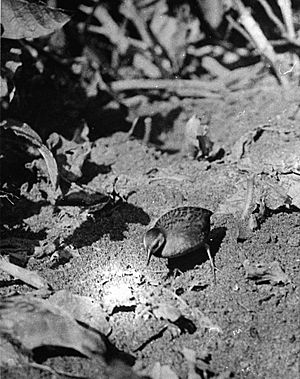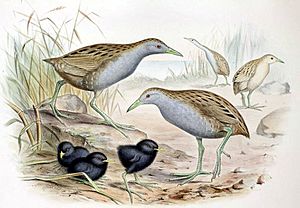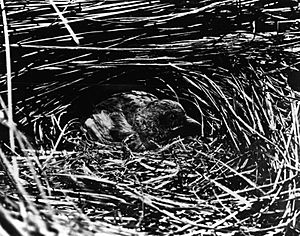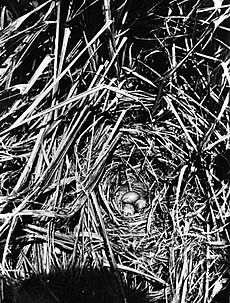Laysan rail facts for kids
Quick facts for kids Laysan rail |
|
|---|---|
 |
|
| 1913 photograph of live specimen by Alfred M. Bailey | |
| Conservation status | |
| Scientific classification | |
| Genus: |
Zapornia
|
| Species: |
palmeri
|
| Synonyms | |
|
Porzana palmeri |
|
The Laysan rail, also known as the Laysan crake, was a small bird that couldn't fly. It lived only on Laysan, a tiny island in the Northwest Hawaiian Islands. This island is a very important home for many seabirds. It also used to have several unique animal species, including this rail. Sadly, the Laysan rail became extinct because its home was destroyed by domestic rabbits. The events of World War II also played a part in its disappearance.
Contents
What Was the Laysan Rail Like?
The Laysan rail was a small bird, about 15 centimeters (6 inches) long from its beak to its tail. It was a member of the rail family, but it had lost the ability to fly over time. Its wings were very small, only about 5.4 centimeters (2.1 inches) long. Its tail was also tiny, just 2.5 centimeters (1 inch).
The bird had a strong, straight beak, about 1.8 centimeters (0.7 inches) long. Its legs were also well-developed, helping it move around quickly.
Colors and Appearance
The Laysan rail looked a bit like a lighter version of the Baillon's crake, a bird it was related to. Its face, throat, and chest were a dull gray color. Its back, wings, and the top of its head were light brown. The feathers on its shoulders and sides were sandy brown.
Its feet and beak were a yellowish-olive green, and its eyes were a bright ruby red. Male and female Laysan rails looked the same. Baby rails were completely black with long, dark legs and a yellow beak. Young birds had a light brown color on their entire underside.
Where Did the Laysan Rail Live?
The Laysan rail lived only on Laysan Island. However, some of these birds were moved to Midway Atoll in the early 1900s, where they also lived for a few decades. There were stories of flightless rails on other Hawaiian islands, but these were likely different species that died out before people from the West arrived.
How Did the Laysan Rail Behave?
The Laysan rail was a clever bird that ate many different things. It mainly ate small creatures like moths, brine flies, and blowflies, along with their young (called larvae). When available, they also ate plant leaves, seeds, and the eggs and bodies of seabirds.
These rails were quite bold and would even fight with other birds, especially the Laysan finch. Finches were good at breaking open seabird eggs, but rails were not. So, the rails would wait near the seabird nests. If a finch cracked an egg, the rail would chase it away and eat the egg's contents! On Midway, rails were even seen stealing food from pet chickens.
Laysan Island does not have fresh water all the time. The rails likely got enough water from their food. But they loved to drink and bathe in puddles after heavy rain or from water left out by people.
Movement and Hiding
Even though they couldn't fly, Laysan rails used their wings to help them balance when running and jumping. They could jump almost a meter (about 3 feet) high! They were quick and always moving. They would hide in tall tussock grass to escape predators or the hot midday sun. If they felt in danger, they often hid in the underground homes of petrels.
The birds were most active in the open during the morning and afternoon. But you could see them all day and hear them calling at night.
Fearless Birds
Laysan rails had few natural enemies, except for occasional attacks by frigatebirds. Everyone who saw them noted how fearless they were. If a person stood still, the rails would come close and even climb on them looking for food scraps. One time, a bird was taken from its nest to photograph its eggs, but it immediately went back to protect them.
The Laysan rail was somewhat territorial, especially during breeding season. On Laysan, there was enough space for about one bird per 10 to 13 square meters (100 to 140 square feet). On Midway, there were fewer birds in the same amount of space. In captivity, two pairs of rails could live in about 8 square meters (86 square feet). If more birds were added, they would start fighting.
Sounds and Calls
When active, Laysan rails would often stop and make one to three soft, musical chirps. During courtship or when defending their territory, two birds would face each other, puff up their feathers, and make rattling, scolding calls. These calls sounded a bit like a mechanical alarm clock.
Soon after the sun went down, all the rails on the island would make a short burst of calls. One observer in 1892 said it sounded like "a handful or two of marbles being thrown on a glass roof and then descending in a succession of bounds." Baby rails also made a lot of noise, and their calls were quite loud for their tiny size.
Reproduction and Life Cycle
On Laysan, the Laysan rails would start looking for mates and building nests in April. Eggs were laid from May to June, with most nesting happening in June and July. There was one report of young birds hatching early in March on Midway, but this was unusual.
On Laysan, nests were built in clumps of native grasses like Cyperus pennatiformis subsp. bryanii and kāwelu (Eragrostis variabilis). They also used introduced Bermuda grass (Cynodon dactylon) around the lagoon. On Midway, they nested in any good hiding spot, like naupaka kahakai (Scaevola taccada) bushes and pōhuehue (Ipomoea pes-caprae subsp. brasiliensis) plants.
The nests were placed on the ground or inside the base of a grass clump. If in a clump, the birds would arrange dried leaves to make a roofed space. This space was reached through a small tunnel about 15 centimeters (6 inches) long. Nests were lined with soft, dry plant material and down from seabirds.
Eggs and Young
A female Laysan rail usually laid 3 eggs, but sometimes only 2. This is fewer than the 5 to 10 eggs laid by related rails on continents. The eggs were oval-shaped, about 31 by 21 millimeters (1.2 by 0.8 inches). They were pale olive-buff in color with irregular marks of light raw sienna or purplish gray.
Male and female rails stayed together for life or for an entire breeding season. They both helped to incubate the eggs, though females seemed to spend more time on the nest. The young birds hatched after about 20 days of incubation. Both parents cared for the chicks for about a month. Just five days after hatching, the young could run as fast as the adults!
One observer described a three-day-old chick as "A black velvet marble rolling along the ground. Its little feet and legs are so small and move so fast that they can hardly be seen."
Why Did the Laysan Rail Disappear?
Laysan Island is still one of the most important seabird colonies in the United States. It is home to thousands of black-footed albatross, Laysan albatross, shearwaters, and terns. The island also had five unique types of land and water birds, including the Laysan rail. The extinction of this bird is especially sad because it could have been prevented.
The Laysan rail first faced danger when domestic rabbits were brought to Laysan. There were no predators to control the rabbits' numbers, so they quickly ate almost all the plants on the island. This turned Laysan into a dusty, barren place. This habitat loss caused the Laysan millerbird and the Laysan honeycreeper to become extinct. The Laysan finch and Laysan duck managed to survive.
In the early 1900s, when the rabbits had just started destroying the plants, there were about 2,000 adult Laysan rails. Their population stayed strong until at least the early 1910s, but then it started to decline. By 1923, only two rails could be found on Laysan. Eight birds were brought from Midway to Laysan at that time, but at least two of them died almost immediately because there wasn't enough food or shelter.
It is believed that the Laysan rail became extinct on Laysan Island during 1923. This was mainly because there wasn't enough nesting habitat left to support the population. The very last Laysan rail was seen on Eastern Island in Midway in June 1944.
Images for kids
See also
 In Spanish: Polluela de Laysan para niños
In Spanish: Polluela de Laysan para niños






